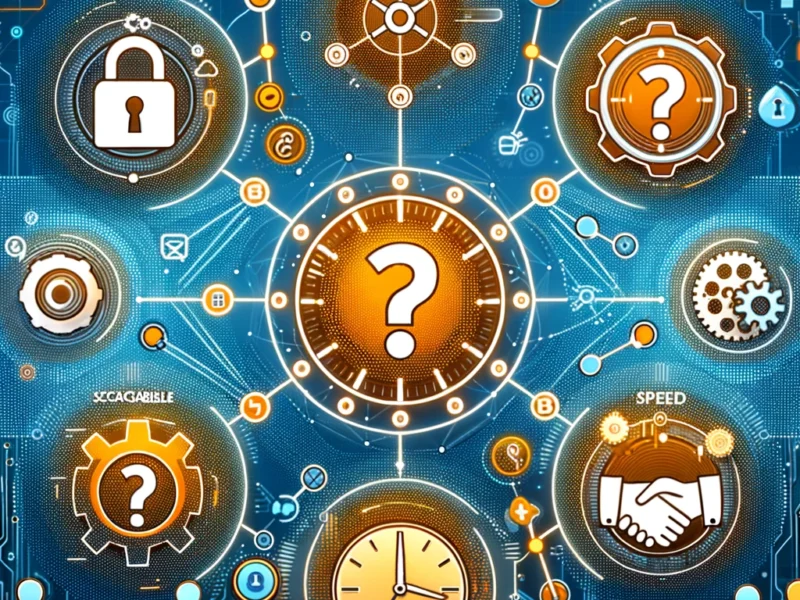Blockchain technology, while decentralized and secure in nature, still faces challenges in maintaining data security. In this article, we explain the challenges to data security in blockchain technology.
1. Natural Blockchain Vulnerabilities
Blockchain operates on the principle of distributed consensus, making it inherently more secure than centralized systems. Yet, this does not render it invulnerable because the security of a blockchain depends on several factors, including network size, consensus mechanisms and smart contract integrity.
Small proof-of-work blockchains, for instance, are more susceptible to 51% attacks, where it’s easy for fraudsters to gain control of the majority of the network’s mining power, compromising its integrity.
Smart contracts (self-executing contracts with the terms directly written into code) are another means of blockchain vulnerability. While they automate and enforce agreements without intermediaries, their immutable nature means that any flaw in the contract’s code is permanent and can be exploited by malicious actors.
The DAO attack on the Ethereum network is a prime example, where attackers exploited a vulnerability to siphon off almost 70 million dollars worth of Ether. This particular incident highlights the need for rigorous smart contract auditing and the development of best practices in smart contract design, which is difficult when we consider human error.
2. Privacy and Data Exposure Concerns
While blockchain’s transparency ensures accountability and traceability, it also raises privacy and sensitive data exposure concerns.
On public blockchains, transaction details are visible to all participants, potentially exposing sensitive information.
Moreover, the immutability of blockchain means that once data is recorded, it cannot be altered or deleted. This poses significant issues for compliance with data protection regulations such as the General Data Protection Regulation (GDPR), which includes a “right to be forgotten.”
To lessen privacy and data exposure risks, blockchain developers have recently employed advanced cryptographic techniques. Zero-knowledge proofs, for instance, enable one party to prove to another that a statement is true without revealing any information beyond the validity of the statement itself.
Another approach is the use of private or permissioned blockchains, where access is restricted to authorized participants, thus offering greater privacy but at the expense of the decentralization that characterizes public blockchains.
These solutions, however, require careful implementation to avoid introducing new vulnerabilities. Additionally, the imbalance transparency and privacy remains a fundamental challenge that necessitates ongoing research and policy development to strike a balance that upholds security without compromising individual privacy.
3. Centralization Risks in Decentralized Systems
One of the core appeals of blockchain is its decentralized nature, eliminating single points of failure and reducing reliance on trusted third parties. However, in practice, blockchain networks often move towards centralization. Good examples of centralization risks are factors such as mining pool dominance, where a few pools control a significant portion of a network’s mining power, and the consolidation of nodes can reintroduce risks associated with centralization, including censorship and targeted attacks.
This centralization also extends to the development and governance of blockchain projects, where a small group wields disproportionate influence over the network’s ecosystem, potentially compromising its integrity and security.
To combat this, several solutions can be considered. First, decentralized autonomous organizations (DAOs) offer a model for more democratic governance of blockchain projects, though they also present challenges in terms of scalability and decision-making efficiency.
Secondly, technical solutions such as sharding, which divides the blockchain into smaller, more manageable pieces (shards) to distribute the workload, can also help reduce the risk of centralization by making it feasible for more participants to run full nodes.
4. Scalability and Security Trade-offs
Blockchain networks face significant scalability challenges as the user base grows; for instance, the Solana network has failed 11 times in 2 years and had to shut down the whole network multiple times since its launch. Increasing the size or speed of the network often requires compromises that can impact security. For example, faster transaction times can lead to a higher risk of double-spending attacks unless additional security measures are put in place.
Thankfully, there have been many solutions, such as layer 2 protocols and sidechains, that can enhance scalability without compromising the security of the main blockchain.
5. Human Errors and Social Engineering Attacks
Despite the technical robustness of blockchain, human errors remain the main source of vulnerability. Social engineering attacks, such as phishing and pretexting, can lead to unauthorized access to wallets and other critical components of the blockchain ecosystem.
The decentralized and pseudonymous nature of blockchain can make it difficult to recover lost assets or hold malicious actors accountable.
Additionally, the complexity and novelty of blockchain technology can lead to user errors, such as lost private keys or sending funds to incorrect addresses, thereby making security challenges worse.
Addressing the challenge of human error in blockchain data security is important. User education and awareness are an obvious solution and defense against social engineering attacks. Wallets and blockchain interfaces must be designed with user safety in mind, incorporating features like multi-factor authentication and address verification to reduce the risk of user error and fraud.
Key Takeaways
1. Inherent Blockchain Vulnerabilities: Despite its secure foundation, blockchain is susceptible to specific vulnerabilities, such as 51% attacks and smart contract exploits, which can undermine network integrity.
2. Privacy vs. Transparency: Blockchain’s transparency, while ensuring accountability, poses privacy risks. Advanced cryptographic methods, like zero-knowledge proofs, are some possible solutions.
3. Centralization Risks in Decentralized Systems: Centralization, through mining pools or governance, contradicts blockchain’s decentralized ethos and introduces vulnerabilities similar to those in traditional centralized systems.
4. Scalability and Security Trade-off: Enhancing blockchain scalability often comes at the risk of compromising security.
5. Human Errors and Social Engineering Threats: Human errors and social engineering attacks remain significant security threats.
Frequently Asked Questions (FAQs)
1. Can a blockchain be hacked despite its security features?
Yes, a blockchain can be vulnerable to certain types of attacks, such as 51% attacks on smaller networks or exploits in smart contract code.
2. How can a blockchain maintain privacy if all transactions are visible?
Answer: While transaction details are transparent, advanced cryptographic techniques like zero-knowledge proofs can validate transactions without revealing the underlying data, thus maintaining privacy.
3. What is a 51% attack, and how likely is it to occur?
A 51% attack happens when fraudsters gain control over the majority of a network’s mining power, potentially allowing them to alter transactions. It’s more feasible on smaller, less secure networks, but less likely on established networks like Bitcoin.
4. How do smart contracts pose security risks to blockchains?
Smart contracts are only as secure as their code. Any flaws in the code can be exploited, and because smart contracts are immutable, these vulnerabilities are permanent unless the contract is updated or a network consensus is reached to rectify the issue.
5. Is the centralization of mining pools a significant concern for blockchain security?
Yes, the dominance of a few mining pools can lead to a form of centralization, posing risks similar to those of traditional centralized systems, such as censorship and targeted attacks, potentially undermining the decentralized nature of blockchain.











2 comments